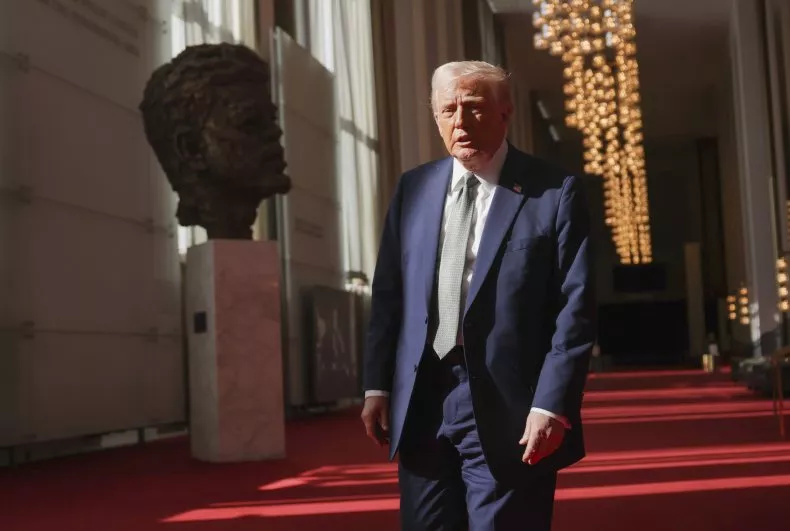In contemporary American politics, the approval rating of a sitting president serves as a barometer for both his political capital and public sentiment. Recent data gathered by AtlasIntel, in a poll conducted from March 7 to March 12 involving 2,550 respondents, indicates a notable decrease in President Donald Trump’s approval rating, which currently stands at 47 percent, juxtaposed by a disapproval rating of 52 percent. This marks a decline from earlier assessments, where Trump’s approval rate was pegged at 50 percent in January and February, highlighting a significant shift in public perception.
This downward trajectory is underscored by Nate Silver, a veteran pollster who lauds AtlasIntel as the most accurate polling entity concerning the 2024 elections. Trump’s approval ratings are pivotal not only for gauging his standing in the political arena but also for forecasting potential ramifications in legislative negotiations and electoral outcomes as he embarks on the complexities of his second presidential term.
The Political Landscape: Influences and Consequences
The implications of Trump’s waning approval ratings are manifold and extend well beyond mere numbers. As Trump grapples with legislative priorities and policy battles, a sustained drop in approval could undermine his influence among Republican lawmakers. Republican support in Congress is crucial for advancing the president’s agenda, and a clear discontent among constituents may compel lawmakers to reassess their allegiance to presidential initiatives.
The growing disapproval among voters appears to be significantly linked to economic dissatisfaction. Polls indicate that over half of respondents disapprove of Trump’s management of the economy, with even higher dissatisfaction relating to inflation and the cost of living. NBC News reports show that 54 percent of voters disapprove of Trump’s economic stewardship, with only 44 percent expressing approval. This sentiment is mirrored in the latest surveys where only 18 percent of voters categorize the economy as “good” or “excellent,” while 43 percent deem it “poor.”
Furthermore, these economic sentiments appear to align with broader societal concerns, particularly regarding employment and inflation. For instance, AtlasIntel’s findings reveal that 54 percent of individuals perceive the economy negatively, reflecting a significant portion of the electorate struggling with financial insecurity. The perception of heightened inflation is underscored by reports from the Labor Department, which showed an alarming increase in consumer prices that have affected everyday purchasing power.
Public Perception of Policy Decisions
Trump’s tariff strategies also contribute heavily to public discontent. Recent polls indicate overwhelming disapproval of his approach, with approximately 61 percent of respondents dissatisfied with his tariff management. This discontent aligns with broader fears that increased tariffs may further exacerbate inflation, prompting anxiety about the potential impact on daily expenses. Respondents overwhelmingly expect such economic policies to lead to heightened prices, revealing a disconnect between the administration’s strategic economic reforms and the reality perceived by the electorate.
Moreover, the push for further tariffs against countries like Canada, Mexico, and China raises questions not only about domestic consumer prices but also about the potential for retaliatory measures, which could stifle economic momentum. Experts, including analysts from Goldman Sachs, predict that these tariffs could catalyze a surge in inflation and damage U.S.-based businesses, consequently dampening public support.
Comparative Analysis: Historical Context
In a historical context, Trump’s approval ratings reflect a stark contrast to his predecessors. As of March 18, 2021, then-President Joe Biden enjoyed a 54 percent approval rating, demonstrating a more favorable public perception at a similar temporal juncture in his presidency. Interestingly, Trump’s current ratings, while lower than Biden’s, indicate a stabilization above his standing at this point in his first term. For example, on March 18, 2017, Trump held an approval rating of just 44 percent, signifying a slight improvement relative to his initial term.
Anticipating the Future: What Lies Ahead
As President Trump navigates the complexities of his administration, the fluctuation of his approval rating will be intrinsically tied to his adeptness in managing critical issues such as the ongoing Russia-Ukraine conflict, the contentious tariff policies, and potential recessionary pressures within the United States. Each of these factors will likely influence public perception and, consequently, his political standing.
The progressive downward drift in approval ratings serves as a call to action for the Trump administration to recalibrate its strategies, particularly with an eye toward addressing pressing economic concerns that resonate deeply with the electorate. As the political landscape continues to evolve, the interplay between Trump’s policy decisions and public sentiment will remain a defining factor in shaping the trajectory of his presidency. Ultimately, the success of his governance may hinge upon his ability to engender tangible improvements in the economy and bolster public confidence in his leadership capabilities.

